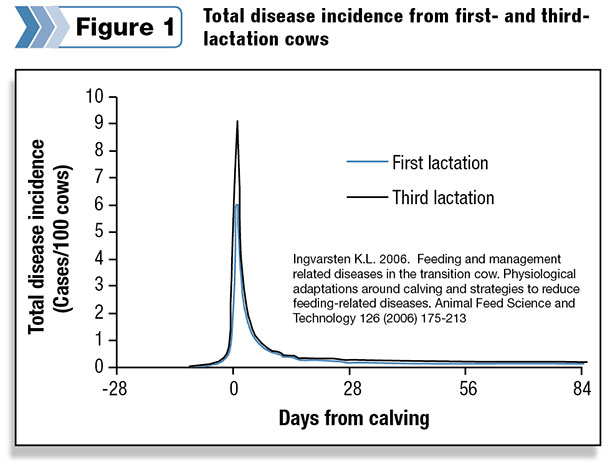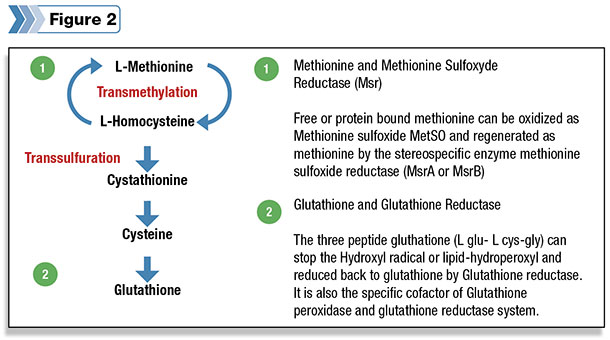Methionine, a required nutrient for cows, has been principally used in dairy rations with the goal of improving milk production or composition. When cows are fed diets enriched with methionine, they respond with an increase in milk volume, an increase in the percentage of protein in the milk, or by a combination of both. Further, it is not uncommon to see an increase in milk fat percentage.
However, this is only the tip of the iceberg of the advantages of enriching dairy rations with methionine. Typically, cows are chronically short in methionine by 10 to 15 percent. This is particularly evident during the transition phase of the lactation cycle.
Cows experience the greatest majority of their diseases during the few weeks after calving ( Figure 1 ). Beyond the high cost of resolving diseases, their impact persists throughout the lactation and can have negative consequences on the herd’s reproduction.

Therefore, it is of utmost importance to help the cow prepare her defense mechanisms already in the prefresh period to avoid metabolic disorders post-calving that lead to unwanted diseases.
Immediately after calving, the cow experiences a negative energy balance due to a relative low dry matter intake versus the high nutrient demands to support milk production. Body reserves are mobilized, leading to potential excessive fat accumulation in the liver. A cow with a fatty liver is prone to experience metabolic problems.
Methionine is an essential amino acid that plays important roles in the cow’s metabolism. Feeding a diet enriched with methionine is important in the synthesis of apoprotein B and in the synthesis of phosphatidyl choline, both necessary for the formation of very low density lipoproteins, which are required for ensuring transport of fat away from the liver.
Another malady that affects cows after calving is excessive inflammation – the response to an offensive challenge to the well-being of the cow.
The onset of lactation is a time when the reactive oxygen species (ROS) can increase drastically, at least in part because of the doubling of metabolic rate in the liver. ROS are oxygen-containing molecules that are chemically reactive.
They are the result of normal metabolism of oxygen, and the cells defend against ROS damage with enzymes referred to as “antioxidants.” Increased ROS are significant contributors to (or consequence of) systemic inflammation.
Reducing oxidative stress can only be beneficial to the cow, particularly during the transition phase. If ROS are produced in excess and the cells’ antioxidant enzymes are unable to counteract this effect in the short term, ROS can cause significant cellular damage.
One of the key antioxidant enzymes in tissues including the liver is glutathione peroxidase. This enzyme can be derived in part via methionine. Preventing ROS accumulation and also providing substrates for antioxidant enzymes during the transition phase may help the cow have a healthier lactation and better overall performance.
It has also been shown in other species that methionine metabolism also plays a key role in decreasing oxidative stress ( Figure 2) .

Results from a research trial that validated the impact of feeding a methionine-enriched diet on the oxidative stress and immune status of cows during transition were recently published. Three groups of cows were fed the same basal diet from 21 days before expected calving day until 28 days after calving.
One group of cows received the basal diet deficient in methionine; the other two groups were fed the same basal diet enriched with one of two commercial methionine sources to achieve a LYS-methionine ratio of 2.8-to-one.
The cows fed the methionine-enriched diets consumed an average of 5.6 extra pounds of feed per day and increased their energy-corrected milk by 8.6 pounds per day during the first 28 days in milk. Also, the cows fed the methionine-enriched diets had greater albumin concentration, an indicator of good liver function.
Those same cows also had lower blood concentrations of haptoglobin, ceruplasmin, serum amyloid A and interleukin-6, indicating a reduced inflammatory response. Furthermore, those cows had a better antioxidant status indicated by a higher oxygen radical absorbance capacity and glutathione concentration.
The authors of the research trial concluded that the cows fed the methionine-enriched diets during the transition period had higher dry matter intake postpartum, produced more energy-corrected milk, had a lower systemic inflammatory state, an enhanced liver function and a greater antioxidant capability.
Methionine is thus a key nutrient in transition cow nutrition, not only as a building block for protein synthesis but as a key intermediate to enhance the metabolic processes.
This can lead to better liver function, oxidative and inflammatory status, thus allowing the dairy cow to withstand the challenges of the transition phase of lactation. The results shown support the hypothesis that feeding a methionine-enriched diet during the transition period is beneficial to cows. PD
Luchini is the manager of ruminant product technical services for Adisseo, has a Ph.D. in dairy science from the University of Wisconsin and has received seven U.S. patents.
References omitted due to space but are available upon request. Click here to email an editor.

-
Daniel Luchini
- Manager of Ruminant Product Technical Services
- Adisseo






